

Spam - netbhas - Gmail. Selective Laser Sintering: Powder test rig by peter_ Builders: Selective Laser Sintering Part 6. Hi folks, I thought I'd take a second to make a quick post about some of the interesting bits of the new open selective laser sintering printer that I've been designing in between finishing up my dissertation.
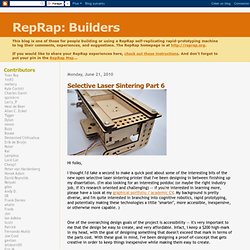
(I'm also looking for an interesting postdoc (or maybe the right industry job, if it's research oriented and challenging) -- if you're interested in learning more, please have a look at my graphical portfolio / academic CV. My background is pretty diverse, and I'm quite interested in branching into cognitive robotics, rapid prototyping, and potentially making these technologies a little "smarter", more accessible, inexpensive, or otherwise more capable. ) One of the overarching design goals of the project is accessibility -- it's very important to me that the design be easy to create, and very affordable. Infact, I keep a $200 high-mark in my head, with the goal of designing something that doesn't exceed that mark in terms of the parts cost. D.I.Y. Selective Laser Sintering at Buildlog.Net Blog.
June 28th, 2010 by bdring There is a great Selective Laser Sintering (SLS) project being blogged at ReRap Builders by Peter Jansen.

Sintering is basically fusing powder by heating it just under the melting point. How Open Source Hardware Is Driving the 3D-Printing Industry. The potential of 3D printing to transform the way we get things - the market is predicted to hit $3.1 billion in the next four years - gets a lot of press.

But not much of that attention has focused on the unique role of open source hardware in enabling 3D printing to realize its promise. Open source software has been a key player in all kinds of disruptive technologies - from the Web to big data. Now the nascent and growing open source hardware movement is helping to power its own disruptive revolution. DIY lab equipment, courtesy of 3D printing. A lot of scientific software is freeware or free/open source software (FOSS).
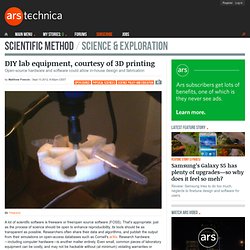
That's appropriate: just as the process of science should be open to enhance reproducibility, its tools should be as transparent as possible. Researchers often share their data and algorithms, and publish the output from their simulations on open-access databases such as Cornell's arXiv. Research hardware—including computer hardware—is another matter entirely. Even small, common pieces of laboratory equipment can be costly, and may not be hackable without (at minimum) violating warranties or terms of use. Imagine a world where lab workers can create their own custom equipment in-house, using either their own designs or ones they've downloaded. With the prices of 3D printers dropping, laboratories at companies and universities have begun using them to build up research equipment. Of course, this won't solve every problem; I can't see inexpensive 3D printers making mass spectrometers in the near future.
Sugru Fixbot by mikevanis. Printrbot LC Build 01. Development. Bukobot 3D Printer - Affordable 3D with No Compromises! by Dieg. Personal Portable 3D Printer. DIY Electronics. Printing Tools. Arduino. Arduino. SLS 3D Printer. An Open Source Laser Sintering 3D Printer. Additive rapid prototyping in plastic materials is becoming quite accessible to home and hobby users.
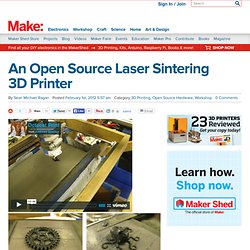
If you’re a hobbyist on a typical budget wanting to rapid prototype in metal, however, you’re limited to subtractive methods, i.e. CNC machine tools like mills and lathes, and even those are not exactly “cheap.” Professional 3D printing services like Shapeways offer additive metal prototyping in metals like stainless steel and gold, but it’s extremely expensive. Building cool robots! The Portable Open Source 3D Printer. You will find the software required for Tanillus here regardless of your operating system.
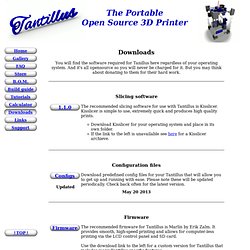
And it's all opensource so you will never be charged for it. But you may think about donating to them for their hard work. Slicing software The recommended slicing software for use with Tantillus is Kisslicer. Kisslicer is simple to use, extremely quick and produces high quality prints. Configuration files Download predefined config files for your Tantillus that will allow you to get up and running with ease. Updated May 20 2013 Firmware The recommended firmware for Tantillus is Marlin by Erik Zalm. Use the download link to the left for a custom version for Tantillus that includes many Tantillus specific features. Slic3r - a STL-to-GCODE translator for RepRap 3D printers. Tantillus portable opensource 3D printer now on Indiegogo. May 16, 2012 Earlier in February we reported the portable Tantillus 3D printer which was ready for beta testing.
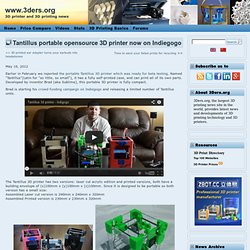
Named "Tantillus"(Latin for "so little, so small"), it has a fully self-printed case, and can print all of its own parts. Developed by inventor Brad (aka Sublime), this portable 3D printer is fully compact. Brad is starting his crowd-funding campaign on Indiegogo and releasing a limited number of Tantillus units. The Tantillus 3D printer has two versions: laser cut acrylic edition and printed versions, both have a building envelope of (x)100mm x (y)100mm x (z)100mm. . - The Laser cut acrylic edition of Tantillus uses the exact same axis parts and electronics as the fully printed version. Each unit weighs only 4kgs with power supply. If you pledge $850 on Indiegogo you will receive a complete kit including everything you need to build a Tantillus.